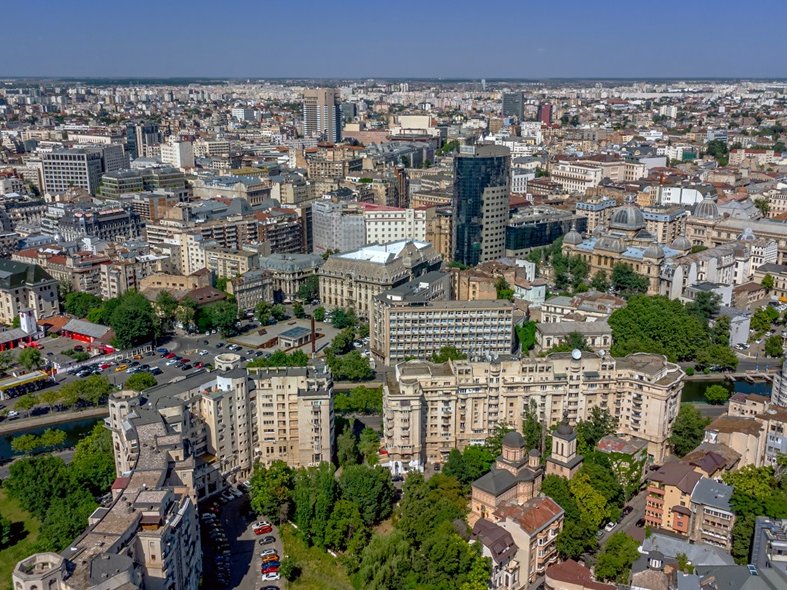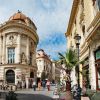Bucharest’s main neighborhoods and the stories behind their names

By Bucharest Team
- Articles
Bucharest is not just a crowded capital, but also a collection of place names that tell the story of the city’s past. Each neighborhood carries a legacy — noble, military, popular, or industrial — and their names are often the key to understanding the identity of the place.
Băneasa – a name with noble roots
The neighborhood’s name comes from the title “băneasa,” meaning the wife of a ban (a high-ranking official). In the 17th century, the estate in the area belonged to a prominent dignitary, and after his death, his wife managed the domain, leaving her mark on the local toponymy. For a long time, Băneasa remained a peripheral area with forests and farmland until the real estate development of the second half of the 20th century. Today, the Băneasa forest and its proximity to the airport define the neighborhood’s identity.
Aviatorilor – in memory of air force heroes
The neighborhood owes its name to Aviatorilor Boulevard and the Monument of the Air Heroes, inaugurated in 1935 to commemorate Romanian aviators who died in service. The area was designed in the interwar period as a protocol axis, with elegant villas, generous gardens, and wide boulevards. It still retains a diplomatic air, hosting embassies and official residences.
Colentina – between legend and reality
The origin of the name Colentina is disputed. One theory says it comes from the Slavic language, possibly from a term referring to flowing or twisting (a reference to the meanders of the Colentina River). Another, more picturesque local legend claims it comes from the expression “colea-n tină” (“over there in the mud”), after Matei Basarab’s army supposedly crossed a muddy terrain here. Until the mid-20th century, Colentina was a separate commune, with villages such as Fundeni and Plumbuita, gradually incorporated into Bucharest.
Crângași – the heirs of the Vlăsiei forest
The name “Crângași” comes from “crâng” – a small forest, part of the ancient Vlăsiei Woods, which once covered much of Wallachia’s north. The “crângași” were people who lived and worked in these wooded areas, often engaged in logging. Large-scale urbanization began in the 1960s, when the area was transformed into a neighborhood of tall apartment blocks.
Pantelimon – from a monastery’s patron saint to an industrial neighborhood
Pantelimon takes its name from Saint Pantelimon, the patron of a monastery built here in the 18th century. Around it grew a settlement that remained rural until the appearance of large industrial platforms in the communist period. After 1965, the neighborhood experienced rapid development, becoming one of the most densely populated areas of the city.
Drumul Taberei – the traces of Tudor Vladimirescu’s troops
The name recalls the year 1821, when Tudor Vladimirescu’s pandurs (militia) set up their military camp in this part of the city’s west. For over a century, the area remained agricultural, with a few farms and orchards. In the 1960s, it was transformed into a modern neighborhood with wide boulevards, apartment blocks of 4–10 stories, and generous green spaces, designed according to Western European urban models.
Cotroceni – the forest of those in hiding
The name comes from the old Romanian verb “a cotroci,” meaning “to shelter” or “to hide.” The Cotroceni forest was once used as a refuge by outlaws or fugitives. In the 17th century, ruler Șerban Cantacuzino built a monastery here, around which the settlement developed. The area later became a royal residence and, in time, one of the most elegant and expensive districts in Bucharest.
Rahova – the memory of the War of Independence
Calea Rahovei, the main road that gave the neighborhood its name, was named after the Romanian victory in 1877 over the Ottoman garrison in Rahova (in present-day Bulgaria). Before this moment, the road was known as “Podul Calicilor” (“The Beggars’ Bridge”), a poor and marginalized area. Over time, Rahova alternated between respectable residential streets and rougher areas, retaining a strong identity in the collective memory of Bucharest.
Ferentari – the echo of Roman legions
The name comes from the Latin “ferentarius,” meaning a light infantry soldier in the Roman army. It is possible that a military training ground or auxiliary camp once existed here. In modern times, Ferentari was a peripheral area with modest housing and factories. After the 1970s, it saw the development of large apartment complexes, but also social problems that have maintained its controversial reputation.
Also recommended Top 5 neighborhoods in Bucharest for digital nomads: where to live and work






























